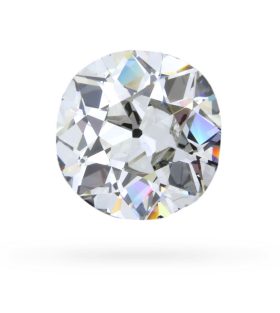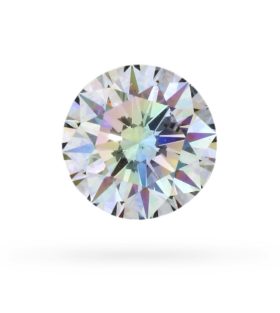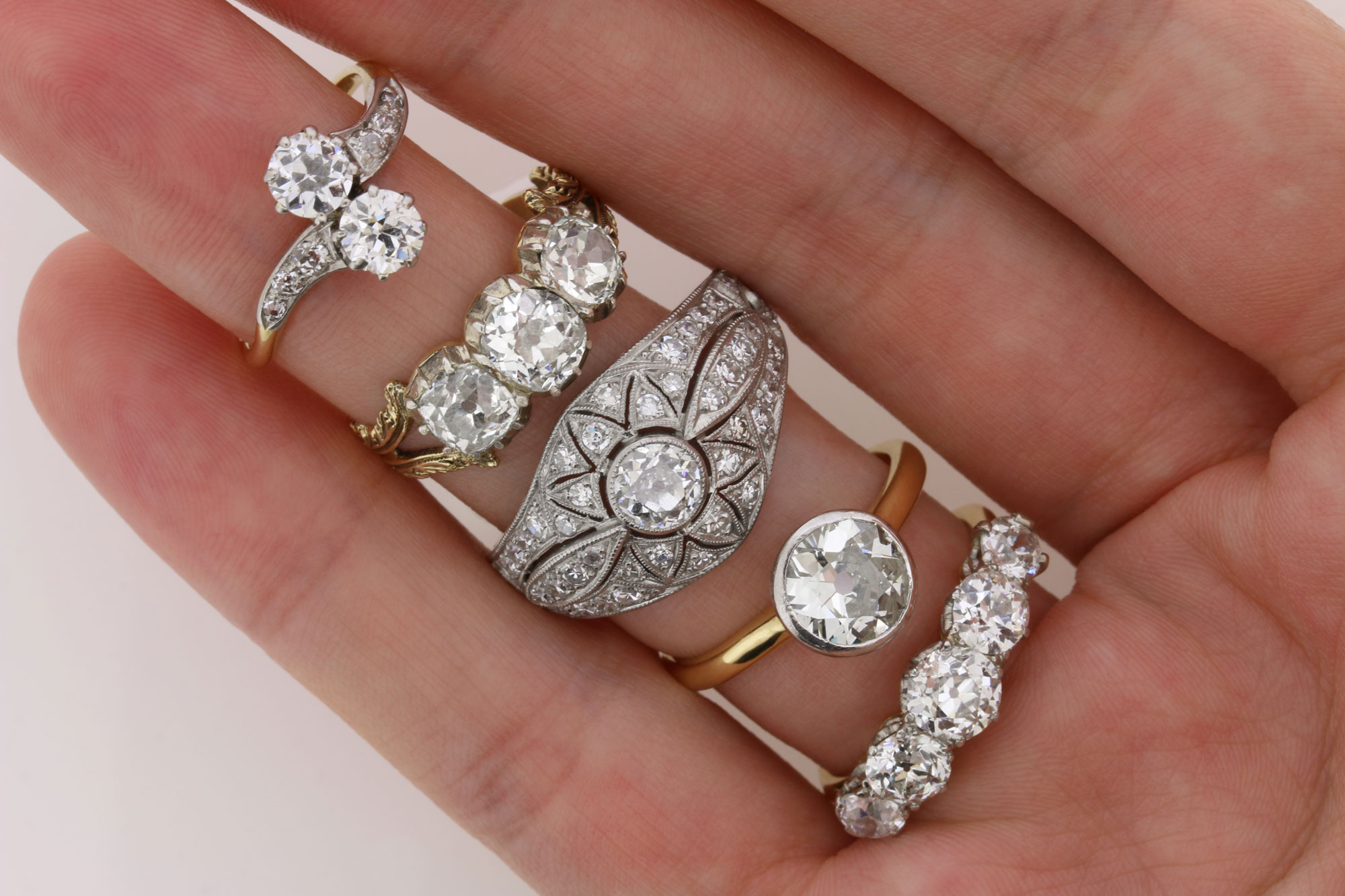Anyone who has shopped for a diamond is probably familiar with the ‘4Cs‘. – cut, colour, clarity, and carat. But how a diamond is cut, and in which style, can dramatically affect its brilliance, aesthetic, and emotional appeal.
In this guide, we explore old cut diamonds versus modern round brilliants, comparing their history, optical effects, and how to choose between them in 2025.
A brief history of old cut diamonds
In the late 1800s and early 1900s, diamond cutting evolved from simple hand-crafted techniques to more refined, mechanical processes. This era gave rise to old cut diamonds, including the Old Mine Cut, Old European Cut, and Transitional Cut.
Because many of these stones were later re-cut into modern shapes, original old-cut diamonds are now increasingly rare. Each one represents a piece of jewellery history full of warmth, individuality and craftsmanship that can’t be replicated by modern machines.
Five characteristics of old cut diamonds vs round brilliants
Shape

HRD certified 3.03ct old European cut diamond.
When viewed from the top, an old cut diamond will be nearly perfectly round, just like a modern round brilliant cut. The invention of steam-driven and electric cutting equipment in the late 1800s finally made it possible to cut round diamonds on an industrial scale.
Cut
Old cut diamonds usually have a small table or top facet. The crown, which is the portion of the stone above its widest point, is generally taller than what we see on modern brilliant cut stones. The pavilion depth, which is the portion of the stone below its widest point, is generally deeper than what we see on modern brilliant cuts. However, when comparing these elements across different stones, it’s important to compare stones of a similar size in order to get an accurate picture.
Number of Facets

Old cut diamonds have 58 facets. Most round brilliant cuts only have 57 due to the fact that most have a pointed culet (see below). While old cut diamonds were cut with an emphasis on maximising their size and enhancing their colour and clarity, round brilliant cut diamonds are cut to maximise their brilliance (hence the name) or the amount of white light that’s reflected internally and externally from the stone.
Faceting and Cutting
One of the things that many people love about old cut diamonds vs round brilliants is that fact that they were cut by hand. Romantics are drawn to the idea of a craftsman at his workbench hand-cutting their stone over a century ago. This legacy is evident as a close look at any old cut diamond will quickly reveal that its facets are bigger and less uniformly-shaped than those of a modern brilliant cut stone. Each stone has its own recognisable sparkle due to the shape, size and placement of its facets.
Symmetry
A Culet
Due to advances in diamond cutting techniques, most modern diamonds have a pointed tip at the bottom, which reflects any light entering the stone. Due to the cutting techniques used to produce old cut diamonds, the pavilion facets are rarely uniformly cut and at the proper angle. This means that old cut diamonds rarely end in a perfect point. Instead, they end with an open culet that may be rough or polished. Diamond cutters at this time believed that the culet let more light into the stone, thereby increasing its brilliance.
To people unfamiliar with old cut diamonds, the culet, which appears as dark circle, can be mistaken for a hole or an inclusion. However, it’s actually the 58th facet and one of the most easily-recognised attributes of old cut diamonds vs round brilliants.

The Beauty of Old Cut Diamonds in Antique Jewellery
Old cut diamonds are found in many Victorian, Edwardian, and Art Deco pieces. Because these diamonds were hand-crafted, no two are exactly alike and each has its own unique symmetry and character.
Authentic old cut stones that remain unaltered are now considered collectable, adding both sentimental and investment value to antique jewellery – their charm lies in their imperfections and in the history they carry through generations.
How to Choose Between Old Cut and Round Brilliant Diamonds
1. Personal Style
- Prefer a crisp, bright sparkle? Choose a modern round brilliant.
- Love vintage charm and individuality? An old cut diamond might be perfect for you.
2. Lighting & Setting
- Round brilliants dazzle under bright or direct light.
- Old cuts emit a romantic glow in candlelight or ambient settings.
3. Value & Availability
- Old cuts are rarer and sometimes command a premium for authenticity.
- Round brilliants are widely available, making them easier to compare and grade.
4. Certification
- Old cuts can receive GIA or IGI grading, but modern standards may not fully reflect their beauty.
- Always view the stone in person or request detailed photos before purchase.
5. Maintenance
- Round brilliants are easier to set and maintain.
- Old cuts may need gentler handling and custom settings due to their unique shapes.
FAQs About Old Cut and Round Brilliant Diamonds
Q1: Is an old cut diamond lower quality than a round brilliant?
Not at all. Old cuts were crafted before modern standards existed, so they prioritise charm and individuality over perfect symmetry. Their beauty lies in their uniqueness.
Q2: Are old cut diamonds valuable?
Yes – authentic old cuts are increasingly rare, especially those still set in antique jewellery. Their historical significance often enhances their value.
Q3: Can I get an old cut diamond certified?
Yes, though grading reports may evaluate them under modern criteria, which don’t always reflect their true appeal.
Q4: Should I re-cut an old diamond into a modern shape?
It’s generally not recommended, as re-cutting removes carat weight and historic value. Many buyers today seek out the distinctive charm of unaltered old cuts.
Q5: Which cut is better for an engagement ring?
If you love timeless sparkle, a round brilliant is a classic choice. If you want a unique, romantic, and story-filled stone, an old cut offers exceptional character.
Both old cut and round brilliant diamonds have their own magic. The modern round brilliant delivers exceptional sparkle and precision, while the old cut diamond embodies history, romance, and individuality.
In 2025, as trends move toward sustainability and conscious luxury, old cut diamonds are enjoying a well-deserved resurgence – proving that sometimes, the most beautiful things are those shaped by time.
When shopping for an old cut diamond, or a modern round brilliant cut, the most important thing is to choose one that you love!





